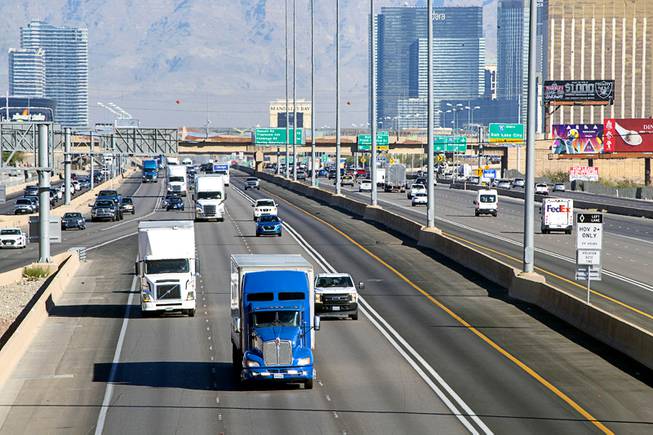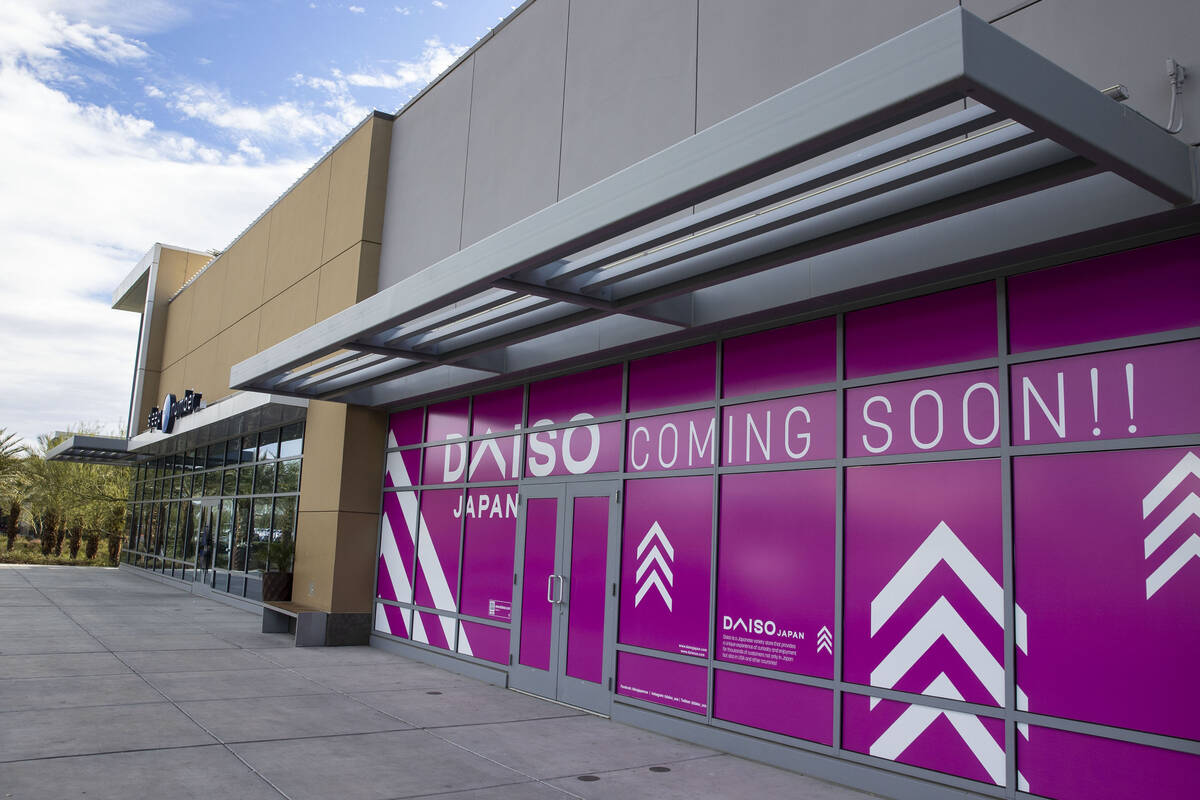Steve Marcus
Tractor units will travel south on Interstate 15 near Blue Diamond Road on Wednesday, October 27, 2021. Truck drivers in Las Vegas and across the country are stretched as demand for goods outweighs supply.
Sunday, October 31, 2021 | 2 a.m
Peppermill Las Vegas is one of the resort corridor’s most iconic nighttime hangouts.
But if you’re craving to order the restaurant’s onion rings, you’re likely out of luck. And some early hours in the morning you won’t be able to place an order at all.
Chef Nicholas Orth is putting together his menu, although he does not know what supplies will be available to him due to the current global challenges in the supply chain. Basic inventory – such as glass cups, soup spoons, embroidered napkins, or paper cups – as well as foods like onion rings take months longer than industrial workers would normally expect. Even when goods are delivered, the brand or appearance of a “sub-item” may differ from the order, which often leads to higher prices for companies.
The global supply chain is a way that connects production with transportation and logistics or the transportation of goods to customers.
Delays and bottlenecks across the supply chain caused by the pandemic affect almost all items produced or manufactured, including those needed for local restaurants like Peppermill.
Orth said his menu is constantly being reinvented, including only onion rings as a hamburger topper and not as a starter or side dish. The shortage also means the restaurant cannot offer its traditional Thanksgiving dinner, he said, because the items are either too expensive or not available.
Additionally, staffing issues have forced the restaurant to reduce its 24-hour dining service from 7 a.m. to 2 a.m. Thursday through Sunday and 7 a.m. to 11 p.m. Monday through Wednesday, and lost weekly revenue.
Both kitchen and waiter staff have shrunk since the pandemic began in March 2020 – not a new problem, but certainly urgent, Orth said.
“If we can solve (the work problems), I think a lot of our problems will slowly go away,” said Orth. “But nobody can do anything without people who work.”
Sometimes the answer to a customer’s request for an unavailable item, like a cup for a takeaway coffee, simply has to be no, said Jason Lapin, president and chief operating officer of Blau Associates, which owns several Las Vegas restaurants including honey salt and Buddy V’s Ristorante.
“We are rowdy and enterprising,” said Lapin. “We make it possible. But yes, there are definitely times when you just don’t have the care you need to achieve something.”
Lapin is also a consultant for major brands and hotels, where the deadlines for ordering new equipment have been stretched to accommodate the now known delays in shipping and delivery. Resort businesses on the Strip are also likely to face challenges, but declined or responded to a request to be part of this story.
Shoppers may have noticed empty shelves in grocery stores and other retailers or delayed delivery dates. Meanwhile, restaurants and other local businesses are waiting for the supplies they need to operate as normally as possible. This reality is the result of congested ports like those in Los Angeles or Long Beach, California, where dock workers work around the clock to ease the bottleneck of cargo ships lined up offshore, and where trucking companies and distribution centers are short on staff move these goods forward.
The main problem is that consumer demand has overtaken the recovery on the manufacturing side of the economy, said Mark Vinter, senior economist at Wells Fargo. And as consumer spending rises near the Christmas season, the lack of additional labor and items makes for an ominous combination.
“Most of our Washington policymakers believe that if you stimulate demand, supply will follow, and many of the actions we have implemented have stimulated demand very well,” said Vinter. “They put money in people’s pockets, but we made it pretty difficult for people to get back to work right away, and that made the situation a little bit worse.”
On the supply side, the scarce labor has also had a negative impact on the Las Vegas-based Desert Eagle Transportation, whose drivers work 14-hour shifts and are limited to 70 hours a week.
Three of those 14 hours are dedicated to loading and unloading in warehouses, said Svetoslav Vitkov, a truck driver with Desert Eagle.
However, with fewer employees lifting deliveries on and off the truck with forklifts, Vitkov said he waited five to six hours instead of three hours to finish his work in the warehouses. Fewer truckers to handle this growing demand only make the problems worse.
“Since not enough people are working, we have more to do,” said Vitkov. “We have so many burdens and we can only do so much.”
Direct solutions, be it on the consumption or sales side, are unclear and will likely persist beyond the holidays, experts say.
The two California ports work 24 hours a day, seven days a week, according to the White House, which on Oct. 13 put a plan in place to ease the bottleneck or restriction and alleviate consumer Christmas concerns.
Logistics company Stord will open a 177,000 square foot warehouse in Las Vegas on Monday Henry. This is Stord’s second warehouse in Nevada – the other in Reno – and will employ over 100 people, he said.
“Los Angeles is running out of space and it’s not economically efficient to store and move your inventory in this market,” said Henry. “Las Vegas is an amazing alternative for those who see more shippers entering the Las Vegas market because of its proximity to the Pacific Corridor.”
Transportation Secretary Pete Buttigieg said Oct. 17 that the complications could extend through 2022 and that the passage of an infrastructure plan in Congress would best alleviate these problems.
“The president’s infrastructure plan is $ 17 billion for ports alone, and we need to address these long-term problems that have left us vulnerable to such bottlenecks when there are fluctuations in demand, shocks and disruptions like the previous ones.” Caused by the pandemic “He said in the” State of the Union “from CNN.
However, Vinter said he didn’t think the federal government could improve the traffic jam noticeably.
“Much of the rhetoric we hear from the federal government is usually just designed to make it look like they’re doing something,” he said. “Unfortunately, this is a global problem. And the world economy has come to a standstill and has reopened in very staggered stages. … We are so dependent on each other for parts and materials that it is very difficult to get the economy going again and everything runs perfectly. “












